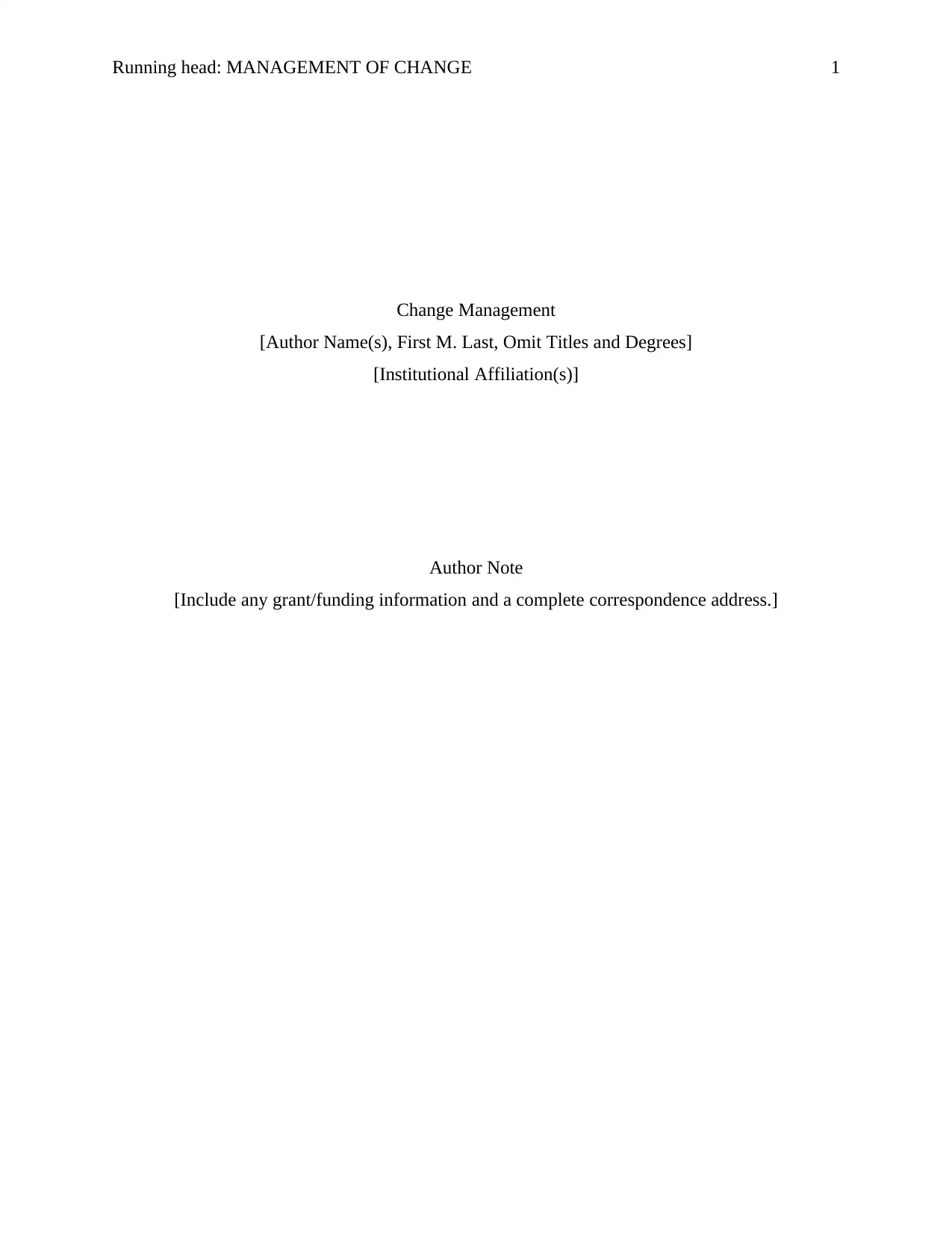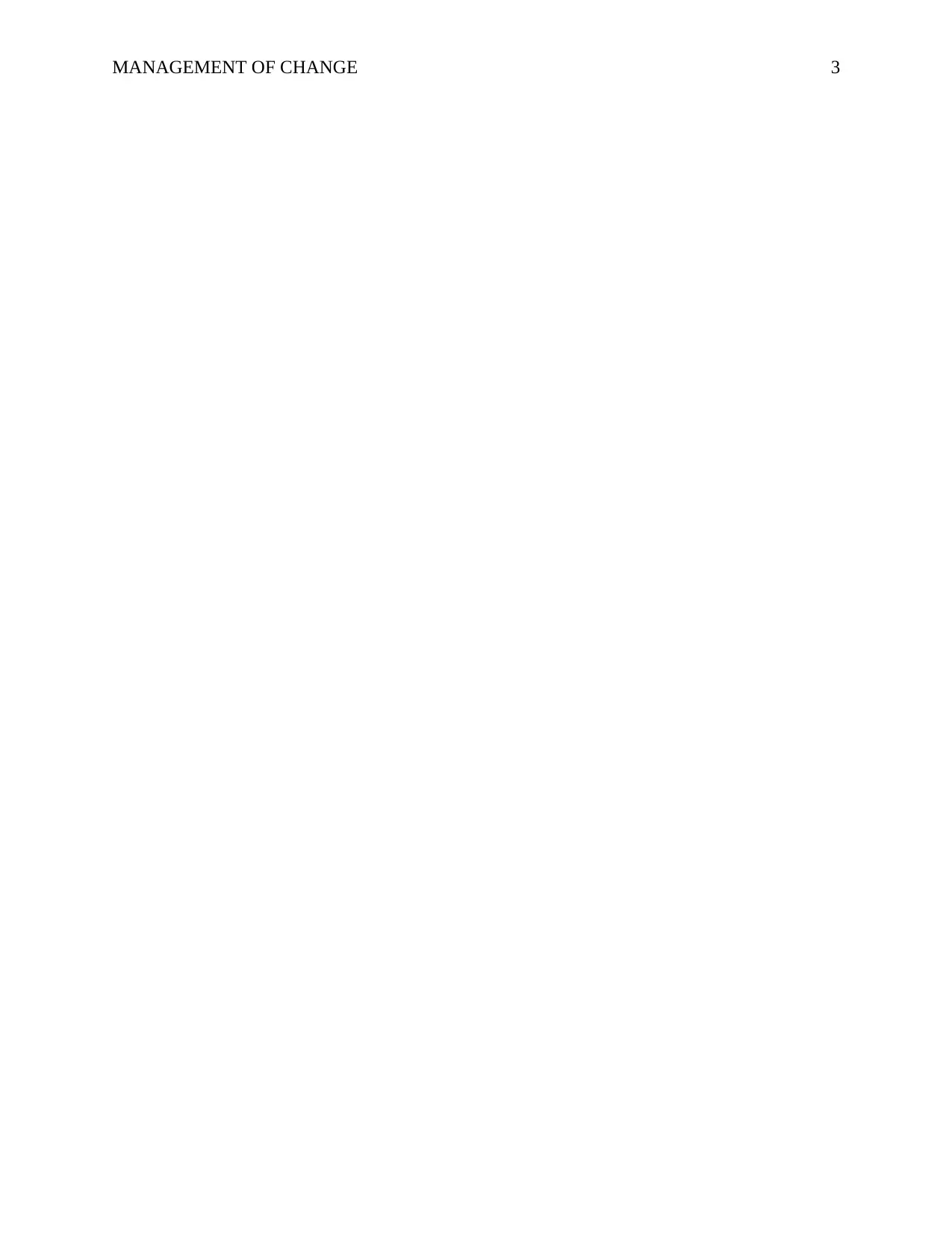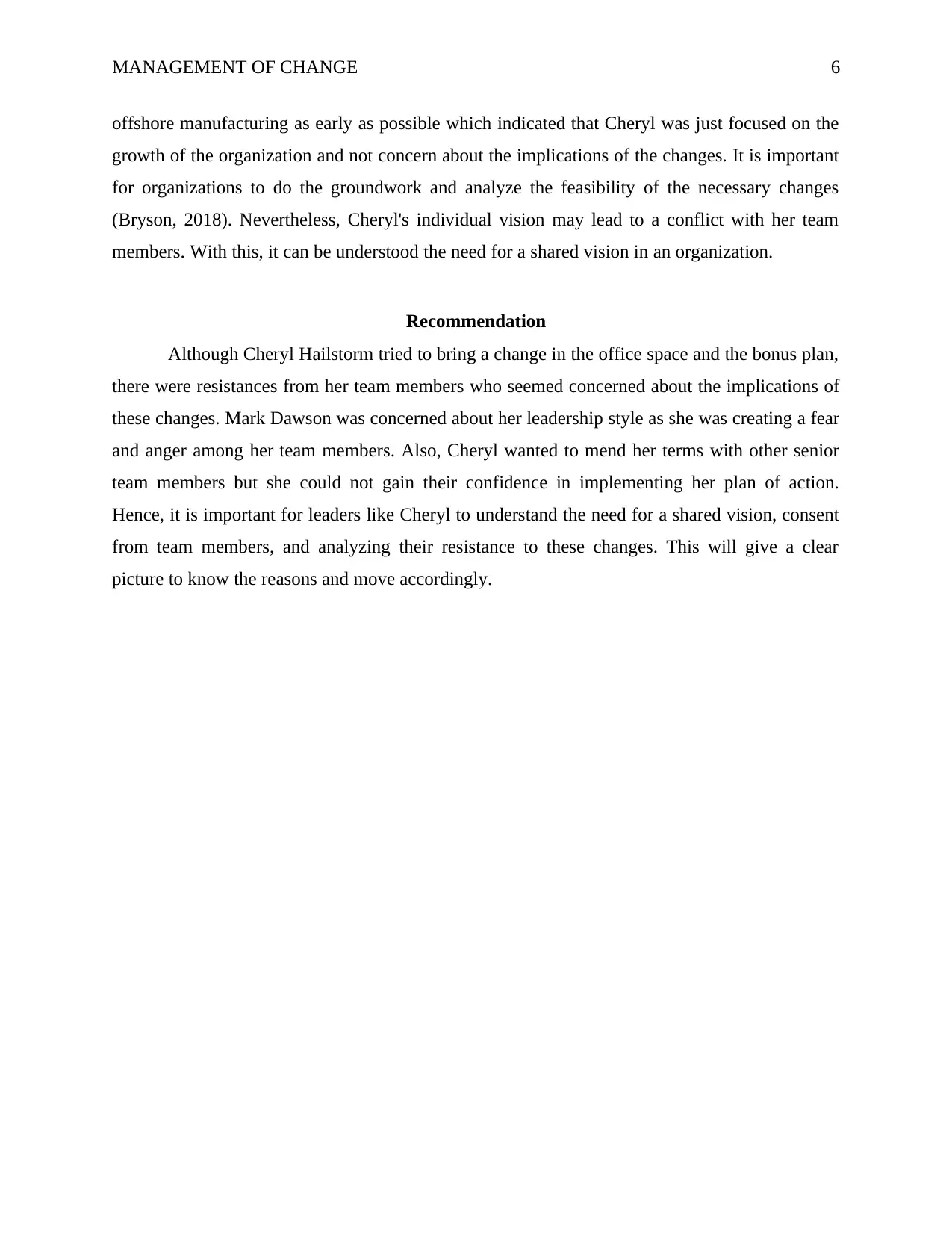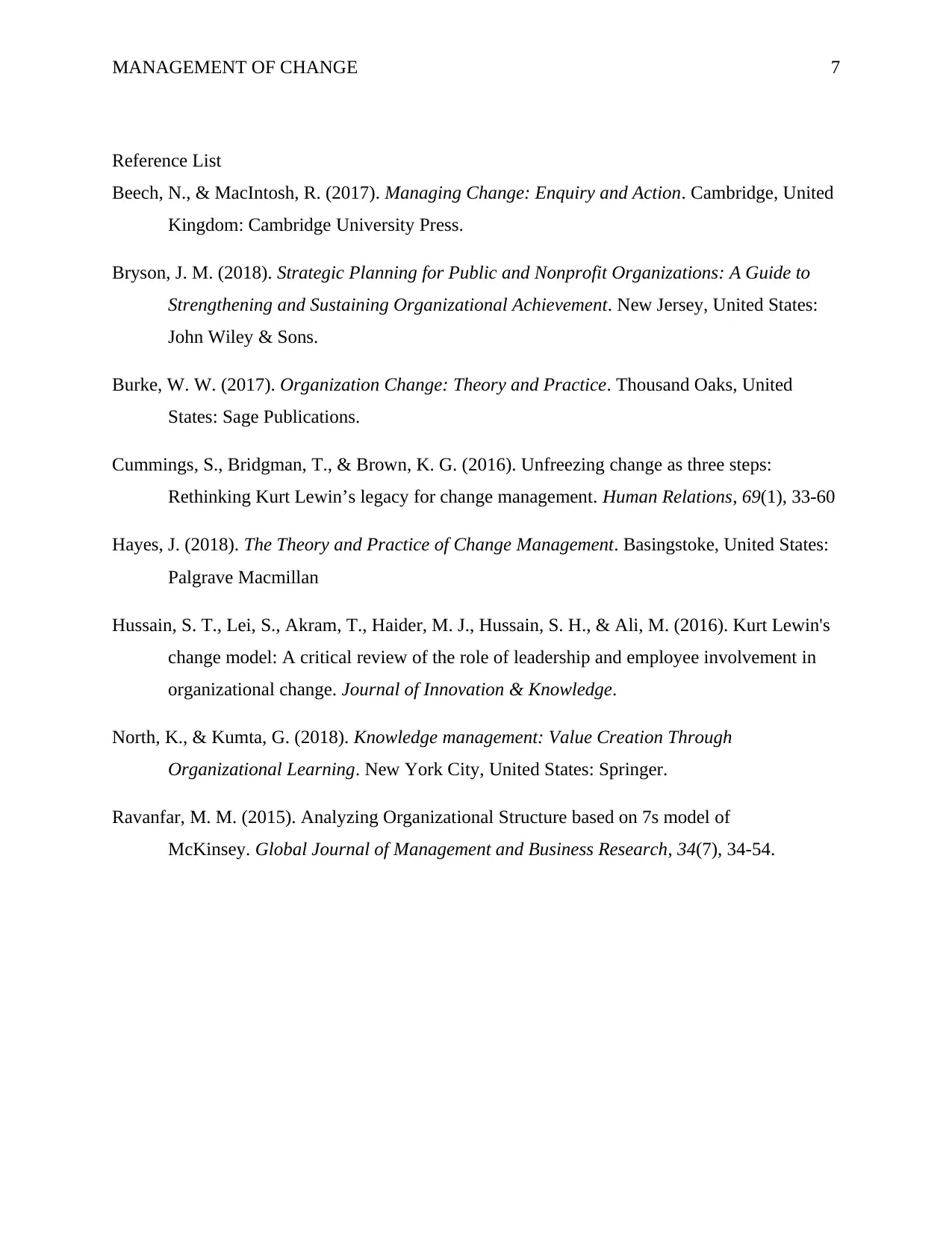Change Management Strategies and Resistance: Lake-Land Wonders
VerifiedAdded on 2023/06/03
|7
|1454
|208
Report
AI Summary
This report delves into the critical aspects of change management within organizations, utilizing the case study of Lake-Land Wonders to illustrate key concepts. It explores various approaches to change management, including Kurt Lewin's Change Management Model and the McKinsey 7S Model, highlighting their application in overcoming resistance to change. The report analyzes the challenges faced by Cheryl Hailstorm, the CEO of Lake-Land Wonders, in implementing organizational changes and addresses the ethical considerations involved. It further examines the resistance encountered from senior management, particularly concerning changes to office space, bonus plans, and offshore manufacturing. The report concludes with recommendations for leaders like Cheryl, emphasizing the importance of shared vision, team member consent, and thorough analysis of resistance to ensure successful change implementation. Desklib provides this assignment solution and other resources for students.

Running head: MANAGEMENT OF CHANGE 1
Change Management
[Author Name(s), First M. Last, Omit Titles and Degrees]
[Institutional Affiliation(s)]
Author Note
[Include any grant/funding information and a complete correspondence address.]
Change Management
[Author Name(s), First M. Last, Omit Titles and Degrees]
[Institutional Affiliation(s)]
Author Note
[Include any grant/funding information and a complete correspondence address.]
Paraphrase This Document
Need a fresh take? Get an instant paraphrase of this document with our AI Paraphraser

MANAGEMENT OF CHANGE 2
Table of Contents
Change Management.......................................................................................................................4
Approaches to Change Management...............................................................................................4
Kurt Lewin’s Change Management Model.................................................................................4
McKinsey 7 S Model...................................................................................................................5
Resistance to changes......................................................................................................................5
Recommendation.............................................................................................................................6
Reference List..................................................................................................................................7
Table of Contents
Change Management.......................................................................................................................4
Approaches to Change Management...............................................................................................4
Kurt Lewin’s Change Management Model.................................................................................4
McKinsey 7 S Model...................................................................................................................5
Resistance to changes......................................................................................................................5
Recommendation.............................................................................................................................6
Reference List..................................................................................................................................7

MANAGEMENT OF CHANGE 3
⊘ This is a preview!⊘
Do you want full access?
Subscribe today to unlock all pages.

Trusted by 1+ million students worldwide

MANAGEMENT OF CHANGE 4
Change Management
Change is an inevitable part of any organization and may arise from the constant need to
improve the business operations, restructure the organization, and bring ethical changes, resource
allocation or other factors to align with the vision of the organization. A change can be brought
into an organizational by challenging the status quo and looking into new ways to improve the
management. The need for change can come from the internal environment, external
environment or from both (Hayes, 2018). Even when there are agents initiating these changes,
there lie certain ethical issues that can create issues during the change process. The following
project is based on the changes required to be made in Lake-Land Wonders and the reasons for
resistance to these changes by the management.
Approaches to Change Management
In order to bring change in an organization, it is important to understand the need for
right strategies to be implemented and focus on the suitable plan of action. It requires time,
dedication, and a lot of efforts from the people in the organization to successfully implement
these changes. Before adopting any change management approach, the organization must figure
out its needs and the reason for such changes. There are few change management approaches that
may help any company to decide on the suitable plan of action.
Kurt Lewin’s Change Management Model
Lewin’s change management model is considered the most suitable and effective model
to understand organizational change. This model was designed by Kurt Lewin in 1950s which
explains an organizational change through the changing shape of a block of ice (Hussain, et. al.,
2016). The first stage is known as Unfreeze which involves with the clear understanding of the
need for a change and the preparedness by the people in the organization to accept the change
(Cummings, 2016). This stage is very important as any significant change may receive resistance
from the existing employees. At this stage, the change and the underlying benefits are explained
to the employees. As per the case study, Cheryl Hailstorm, the CEO of Lake-Land Wonders was
an enthusiastic lady who wished to bring changes in the organization but received resistance
from her board members. According to the second step the change has to implement by good
Change Management
Change is an inevitable part of any organization and may arise from the constant need to
improve the business operations, restructure the organization, and bring ethical changes, resource
allocation or other factors to align with the vision of the organization. A change can be brought
into an organizational by challenging the status quo and looking into new ways to improve the
management. The need for change can come from the internal environment, external
environment or from both (Hayes, 2018). Even when there are agents initiating these changes,
there lie certain ethical issues that can create issues during the change process. The following
project is based on the changes required to be made in Lake-Land Wonders and the reasons for
resistance to these changes by the management.
Approaches to Change Management
In order to bring change in an organization, it is important to understand the need for
right strategies to be implemented and focus on the suitable plan of action. It requires time,
dedication, and a lot of efforts from the people in the organization to successfully implement
these changes. Before adopting any change management approach, the organization must figure
out its needs and the reason for such changes. There are few change management approaches that
may help any company to decide on the suitable plan of action.
Kurt Lewin’s Change Management Model
Lewin’s change management model is considered the most suitable and effective model
to understand organizational change. This model was designed by Kurt Lewin in 1950s which
explains an organizational change through the changing shape of a block of ice (Hussain, et. al.,
2016). The first stage is known as Unfreeze which involves with the clear understanding of the
need for a change and the preparedness by the people in the organization to accept the change
(Cummings, 2016). This stage is very important as any significant change may receive resistance
from the existing employees. At this stage, the change and the underlying benefits are explained
to the employees. As per the case study, Cheryl Hailstorm, the CEO of Lake-Land Wonders was
an enthusiastic lady who wished to bring changes in the organization but received resistance
from her board members. According to the second step the change has to implement by good
Paraphrase This Document
Need a fresh take? Get an instant paraphrase of this document with our AI Paraphraser

MANAGEMENT OF CHANGE 5
leadership and assurance. Cheryl could not implement her changes as she needed to make her
team understand the need for this change. However, her team wanted her to slow down on her
plans.
The third stage explains about the after effect of the change which is called as refreeze. At this
stage, the organization begins to adapt to the relevant changes and get accustomed to the new
way of working (Hussain, et. al., 2016).). Cheryl too wished to implement positive changes as
early as possible but due to a less enthusiastic team, she could not take steps further.
McKinsey 7 S Model
McKinsey 7 S Model is still considered as an important framework to manage a change.
The framework comprises of 7 stages that helps to develop a structured plan (Ravanfar, 2015).
The first stage is to coin the suitable strategy to implement the desired change. The second stage
is to make changes keeping in mind the structure of the organization. The third stage involves the
system of performing the day-to-day activities. The fourth stage is to align the necessary change
with the shared values of the organization. The fifth stage involves the style of leadership
adopted by the organization to get the work done. The sixth stage requires the involvement of the
staff to smoothly carry out the change. The seventh and last change requires the involvement of
skilled and competent staff who understands the necessary changes. These stages may give
proper direction to any organization to consider important aspects of the change (Beech &
MacIntosh, 2017).
Resistance to changes
Although there are initiatives taken to develop appropriate organizational culture, there
will always be a resistance to these changes in any organization. However, it becomes the
responsibility of the senior management to promote organizational growth by looking for
possible opportunities (North & Kumta, 2018)). As per the case study, Cheryl wanted to change
the culture of the organization which was resisted by Mark Dawson who was her Senior Vice
President of operations. Cheryl tried to implement the changes but listening to the senior
management would have not attracted their resistance towards this change. Her style of
leadership could not focus on the vision of the company which failed to create a sense of urgency
of the required change in the organization (Burke, 2017). On the other hand, she wished to start
leadership and assurance. Cheryl could not implement her changes as she needed to make her
team understand the need for this change. However, her team wanted her to slow down on her
plans.
The third stage explains about the after effect of the change which is called as refreeze. At this
stage, the organization begins to adapt to the relevant changes and get accustomed to the new
way of working (Hussain, et. al., 2016).). Cheryl too wished to implement positive changes as
early as possible but due to a less enthusiastic team, she could not take steps further.
McKinsey 7 S Model
McKinsey 7 S Model is still considered as an important framework to manage a change.
The framework comprises of 7 stages that helps to develop a structured plan (Ravanfar, 2015).
The first stage is to coin the suitable strategy to implement the desired change. The second stage
is to make changes keeping in mind the structure of the organization. The third stage involves the
system of performing the day-to-day activities. The fourth stage is to align the necessary change
with the shared values of the organization. The fifth stage involves the style of leadership
adopted by the organization to get the work done. The sixth stage requires the involvement of the
staff to smoothly carry out the change. The seventh and last change requires the involvement of
skilled and competent staff who understands the necessary changes. These stages may give
proper direction to any organization to consider important aspects of the change (Beech &
MacIntosh, 2017).
Resistance to changes
Although there are initiatives taken to develop appropriate organizational culture, there
will always be a resistance to these changes in any organization. However, it becomes the
responsibility of the senior management to promote organizational growth by looking for
possible opportunities (North & Kumta, 2018)). As per the case study, Cheryl wanted to change
the culture of the organization which was resisted by Mark Dawson who was her Senior Vice
President of operations. Cheryl tried to implement the changes but listening to the senior
management would have not attracted their resistance towards this change. Her style of
leadership could not focus on the vision of the company which failed to create a sense of urgency
of the required change in the organization (Burke, 2017). On the other hand, she wished to start

MANAGEMENT OF CHANGE 6
offshore manufacturing as early as possible which indicated that Cheryl was just focused on the
growth of the organization and not concern about the implications of the changes. It is important
for organizations to do the groundwork and analyze the feasibility of the necessary changes
(Bryson, 2018). Nevertheless, Cheryl's individual vision may lead to a conflict with her team
members. With this, it can be understood the need for a shared vision in an organization.
Recommendation
Although Cheryl Hailstorm tried to bring a change in the office space and the bonus plan,
there were resistances from her team members who seemed concerned about the implications of
these changes. Mark Dawson was concerned about her leadership style as she was creating a fear
and anger among her team members. Also, Cheryl wanted to mend her terms with other senior
team members but she could not gain their confidence in implementing her plan of action.
Hence, it is important for leaders like Cheryl to understand the need for a shared vision, consent
from team members, and analyzing their resistance to these changes. This will give a clear
picture to know the reasons and move accordingly.
offshore manufacturing as early as possible which indicated that Cheryl was just focused on the
growth of the organization and not concern about the implications of the changes. It is important
for organizations to do the groundwork and analyze the feasibility of the necessary changes
(Bryson, 2018). Nevertheless, Cheryl's individual vision may lead to a conflict with her team
members. With this, it can be understood the need for a shared vision in an organization.
Recommendation
Although Cheryl Hailstorm tried to bring a change in the office space and the bonus plan,
there were resistances from her team members who seemed concerned about the implications of
these changes. Mark Dawson was concerned about her leadership style as she was creating a fear
and anger among her team members. Also, Cheryl wanted to mend her terms with other senior
team members but she could not gain their confidence in implementing her plan of action.
Hence, it is important for leaders like Cheryl to understand the need for a shared vision, consent
from team members, and analyzing their resistance to these changes. This will give a clear
picture to know the reasons and move accordingly.
⊘ This is a preview!⊘
Do you want full access?
Subscribe today to unlock all pages.

Trusted by 1+ million students worldwide

MANAGEMENT OF CHANGE 7
Reference List
Beech, N., & MacIntosh, R. (2017). Managing Change: Enquiry and Action. Cambridge, United
Kingdom: Cambridge University Press.
Bryson, J. M. (2018). Strategic Planning for Public and Nonprofit Organizations: A Guide to
Strengthening and Sustaining Organizational Achievement. New Jersey, United States:
John Wiley & Sons.
Burke, W. W. (2017). Organization Change: Theory and Practice. Thousand Oaks, United
States: Sage Publications.
Cummings, S., Bridgman, T., & Brown, K. G. (2016). Unfreezing change as three steps:
Rethinking Kurt Lewin’s legacy for change management. Human Relations, 69(1), 33-60
Hayes, J. (2018). The Theory and Practice of Change Management. Basingstoke, United States:
Palgrave Macmillan
Hussain, S. T., Lei, S., Akram, T., Haider, M. J., Hussain, S. H., & Ali, M. (2016). Kurt Lewin's
change model: A critical review of the role of leadership and employee involvement in
organizational change. Journal of Innovation & Knowledge.
North, K., & Kumta, G. (2018). Knowledge management: Value Creation Through
Organizational Learning. New York City, United States: Springer.
Ravanfar, M. M. (2015). Analyzing Organizational Structure based on 7s model of
McKinsey. Global Journal of Management and Business Research, 34(7), 34-54.
Reference List
Beech, N., & MacIntosh, R. (2017). Managing Change: Enquiry and Action. Cambridge, United
Kingdom: Cambridge University Press.
Bryson, J. M. (2018). Strategic Planning for Public and Nonprofit Organizations: A Guide to
Strengthening and Sustaining Organizational Achievement. New Jersey, United States:
John Wiley & Sons.
Burke, W. W. (2017). Organization Change: Theory and Practice. Thousand Oaks, United
States: Sage Publications.
Cummings, S., Bridgman, T., & Brown, K. G. (2016). Unfreezing change as three steps:
Rethinking Kurt Lewin’s legacy for change management. Human Relations, 69(1), 33-60
Hayes, J. (2018). The Theory and Practice of Change Management. Basingstoke, United States:
Palgrave Macmillan
Hussain, S. T., Lei, S., Akram, T., Haider, M. J., Hussain, S. H., & Ali, M. (2016). Kurt Lewin's
change model: A critical review of the role of leadership and employee involvement in
organizational change. Journal of Innovation & Knowledge.
North, K., & Kumta, G. (2018). Knowledge management: Value Creation Through
Organizational Learning. New York City, United States: Springer.
Ravanfar, M. M. (2015). Analyzing Organizational Structure based on 7s model of
McKinsey. Global Journal of Management and Business Research, 34(7), 34-54.
1 out of 7
Related Documents
Your All-in-One AI-Powered Toolkit for Academic Success.
+13062052269
info@desklib.com
Available 24*7 on WhatsApp / Email
![[object Object]](/_next/static/media/star-bottom.7253800d.svg)
Unlock your academic potential
Copyright © 2020–2025 A2Z Services. All Rights Reserved. Developed and managed by ZUCOL.





